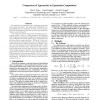Free Online Productivity Tools
i2Speak
i2Symbol
i2OCR
iTex2Img
iWeb2Print
iWeb2Shot
i2Type
iPdf2Split
iPdf2Merge
i2Bopomofo
i2Arabic
i2Style
i2Image
i2PDF
iLatex2Rtf
Sci2ools
CVPR
1996
IEEE
1996
IEEE
Comparison of Approaches to Egomotion Computation
We evaluated six algorithms for computing egomotion from image velocities. We established benchmarks for quantifying bias and sensitivity to noise, and for quantifying the convergence properties of those algorithms that require numerical search. Our simulation results reveal some interesting and surprising results. First, it is often written in the literature that the egomotion problem is difficult because translation (e.g., along the X-axis) and rotation (e.g., about the Y-axis) produce similar image velocities. We found, to the contrary, that the bias and sensitivity of our six algorithms are totally invariant with respect to the axis of rotation. Second, it is also believed by some that fixating helps to make the egomotion problem easier. We found, to the contrary, that fixating does not help when the noise is independent of the image velocities. Fixation does help if the noise is proportional to speed, but this is only for the trivial reason that the speeds are slower under fixati...
Computer Vision | CVPR 1996 | Egomotion Problem | Image Velocities | Similar Image Velocities | Trivial Reason |
| Added | 12 Oct 2009 |
| Updated | 12 Oct 2009 |
| Type | Conference |
| Year | 1996 |
| Where | CVPR |
| Authors | Tina Yu Tian, Carlo Tomasi, David J. Heeger |
Comments (0)

